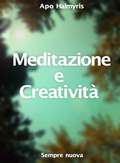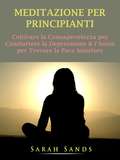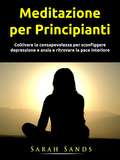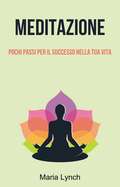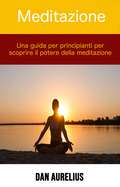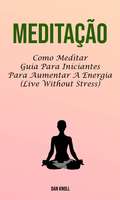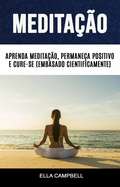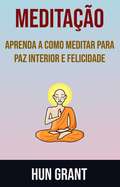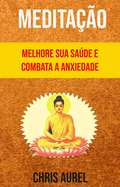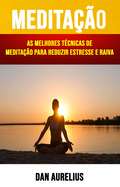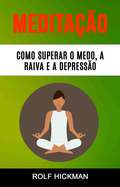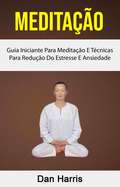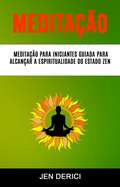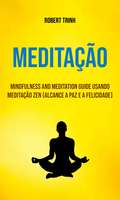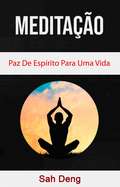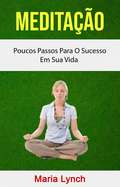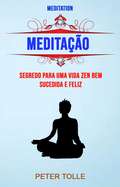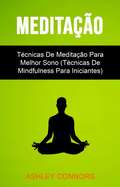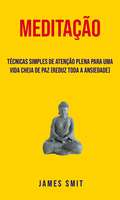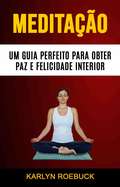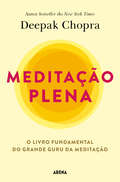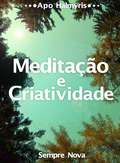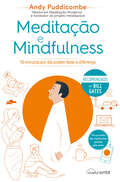- Table View
- List View
Meditazione e Creatività: Sempre nuova
by Apo Halmyris Francesca DeganiLa meditazione e la concentrazione nelle loro forme classiche sono sempre strumenti preziosi per ampliare gli orizzonti della nostra creatività. In ogni contesto cultural e religioso, le tecniche sperimentate da secoli sono sempre attuali e nuove per noi. Questa seconda edizione sottolinea l'approccio pragmatico e offre una serie di tecniche preparatorie per un cammino attento e sicuro verso la meditazione. Per familiarizzarsi con alcuni modi per stimolare la creatività, occorrono tempo, perseveranza e attenzione. Apprendere i metodi di meditazione è impegnativo, ma è di per sé un premio. Oggi normalmente molti studenti esplorano vari tipi di corsi e di tecniche, e chiedono: perché devo fare così? Che cosa posso "ottenere" da questo? Come posso utilizzarlo? (tutte domande centrate sull'Io). Potremmo semplicemente sorridere e spiegare chiaramente alcune procedure per la concentrazione, efficaci anche per ampliare i limiti del pensiero e della creatività. E per i cercatori sul sentiero... possiamo invitarli a guardare la punta delle loro scarpe, perché il sentiero è proprio lì, sotto i loro piedi. Questo testo è un corso pratico graduale, o piuttosto un sentiero contemporaneo per proseguire la scoperta consapevole di se stessi? Le luci discrete delle lampade a olio disseminate dai maestri sono ancora visibili.
Meditazione per Principianti: Coltivare la Consapevolezza per Combattere la Depressione & l’Ansia per Trovare la Pace Interiore
by Hiddenstuff EntertainmentTi piacerebbe essere in grado di eliminare il malessere, avere meno ansia, dormire meglio con la mente più lucida, e combattere la depressione? Per moltissimo tempo, le tecniche di consapevolezza acquisita tramite la meditazione sono state usate per trattare un gran numero di malanni, permettendo alle persone di vivere una vita più felice e sana! Usare le tecniche di guarigione meditative ti aiuterà anche con le malattie croniche, con le infiammazioni, aiuterà a migliorare il tuo sistema immunitario, i tuoi livelli di energia, la concentrazione, la felicità generale, e molto altro! Sperimenta emozioni più positive e meno depressione. Introduci nella tua vita i segreti della guarigione naturale che i professionisti usano per sentirsi più sani che mai! Con decenni di strategie testate, questo ebook ti mostrerà il modo più veloce ed efficace per utilizzare la meditazione per migliorare il tuo benessere! Questo manuale ti insegnerà tecniche comprovate senza l'utilizzo di supplementi o corsi costosi. Ciò include: - Combattere la depressione. - Rimedi. - Combattere lo stress. - Ridurre & eliminare l'ansia. - Avere più energie. - Dormire meglio. - Consapevolezza. - Superare i malanni. - Nutrizione. - Cosa dovresti sapere. + MOLTO ALTRO! Se vuoi essere più sano, curare i malanni, o migliorare la concentrazione & il benessere, allora questo manuale fa per te. --> Vai in cima alla pagina e clicca su aggiungi al carrello per acquistare immediatamente Disclaimer: This author and or rights owner(s) make no claims, promises, or guarantees in regards to the accuracy, completeness, or adequacy of the contents of this book, and expressly disclaims liability for errors and omissions in the contents within. This product is for reference use only. Please consult a professional before taking action on any of the contents found within.
Meditazione per Principianti: Coltivare la consapevolezza per sconfiggere depressione e ansia e ritrovare la pace interiore
by Sarah SandsTi piacerebbe essere in grado di limitare il senso di disagio, gestire meglio l'ansia, dormire a mente chiara e sconfiggere la depressione? Per molto tempo, la consapevolezza attraverso la meditazione è stata utilizzata per trattare una serie di disturbi, permettendoti di vivere una vita più felice e più sana. Questo ebook ti mostrerà il modo più veloce ed efficace per usare la meditazione a beneficio del tuo benessere.
Meditazione: Pochi Passi Per Il Successo Nella Tua Vita
by Maria Lynch¿Está interesado en aprender más sobre meditación? ¿La idea de meditar durante horas y horas lo desanima? ¿Le preocupan el estrés y demandas en tu vida y no encuentras la manera de cambiar el rumbo? Si a regañadientes ha contestado si a una o más de estas preguntas, la meditación para principiantes realmente lo ayudará. ¡Toma to copia hoy clickeando en esta página!
Meditazione: una guida per principianti per scoprire il potere della meditazione
by Melody BoruckiIn Occidente, sempre più persone perseguono lo yoga nelle sue varie forme (nei centri tradizionali, in club sportivi, o da soli), cominciando a rendersi conto che, lungi dall'essere solo un altro esercizio di routine, lo yoga è una disciplina del corpo e della mente. Che vengano usate al mattino per dare dare energia alla giornata, durante l'esercizio yoga stesso, o a fine giornata, le riflessioni quotidiane sulla meditazione sosterranno e miglioreranno la tua esperienza dello yoga.
Meditação (Live Without Stress): Como viver seus momentos, sem stress e preocupações em um estado constante de paz e felicidade
by Akshat AgrawalCada meditação deste livro tem alguns pensamentos para a sua reflexão e tem uma afirmação única no final, que você usa para a sua meditação. Você deve ler atentamente as reflexões contidas e depois meditar sobre a afirmação. O livro inclui capítulos sobre atuação na zona, confiança, planejamento de sucesso, ser um líder forte, ter conversas poderosas, lidar com barreiras ao sucesso, ter uma visão poderosa, treinar bem, ser saúde, ser um espírito livre, ser centrado e criativo e ser mentalmente resistente. É cientificamente comprovado que a meditação exibe benefícios mentais e físicos para aqueles que tiram tempo do dia regularmente para praticar a meditação. Alguns dos benefícios são cientificamente comprovados da meditação ,como, o aumento de foco, que resulta em uma diminuição da ansiedade e do estresse emocional, e é ótimo para pessoas que sofrem de ansiedade ou outros transtornos relacionados ao humor. Para aqueles que sofrem de ataques de pânico, uma forma extrema de ansiedade que é acompanhada por sentimentos de medo e respostas físicas, como aumento do batimento cardíaco e aumento da adrenalina, praticando meditação pode ajudar a minimizar esses sintomas quando no meio de um ataque, e pode ajudar prevenir futuros ataques.
Meditação (Embasado Cientificamente): Aprenda Meditação, Permaneça Positivo e Cure-se (Embasado Cientificamente)
by Ella CampbellOi meu nome é Akshat Agrawal. Eu tenho me auto publicado por cerca de 2 anos e devo dizer que tem sido uma jornada bastante marcante para mim. Eu escrevi livros sob vários gêneros e sob diferentes pseudônimos. Eu escrevo fantasia de ficção para crianças (incluindo livros sobre Minecraft), livros espirituais e livros de entretenimento. Alguns dos meus livros infantis alcançaram o top 100 da Amazon. Um de meu livro chamado Minecraft: Battle of Legends, escrito sob o pseudônimo de Alex Aanderson, tem cerca de mais de 500 avaliações com uma classificação média de 4.19 no Goodreads. Você pode verificar esse livro em Goodreads. Além disso, tenho vários livros de ficção científica promissores com um enredo único e uma sensação de super-herói. Se alguém não está interessado em ficção, então eu tenho outros livros que são baseados em meditação e outros conceitos superlegais como Sonhos Lúcidos. Eu produzo livros regularmente e estou procurando por tradutores que possam me ajudar a alcançar um público mais amplo.
Meditação - Aprenda A Como Meditar Para Paz Interior E Felicidade: Aprenda a como meditar para paz interior e felicidade
by Hun GrantMeditação é uma forma de exercício cuidadoso com foco em ajudar as pessoas a sair de seus estresses diários da vida e ter uma vida atenciosa e relaxada. Meditações têm sido seguidas por muitas pessoas em todo o mundo. É um exercício fácil que requer apenas concentração e consistência. Ela ajuda as pessoas a lidarem com os estresses diários da vida e previnem a acumulação desses estresses. Permite que a pessoa aproveite a vida em sua totalidade. Pode preencher a vida das pessoas com felicidade e contenção. Ajuda a manter o corpo em forma com uma harmonia completa. Também fortalece o funcionamento de órgãos sensoriais. A meditação aumenta a habilidade institutiva do corpo e auxilia na tomada de decisões com grande facilidade. Também ajuda a reduzir a raiva das pessoas. A prática da meditação está sendo cada vez mais vista como um dos métodos mais poderosos de auto-consciência e auto-melhora por todo o mundo. Meditação é considerada como o método preferido de relaxamento e controle do estresse, com o objetivo de aprimorar a saúde geral, tanto física quanto mental.
Meditação - Melhore Sua Saúde E Combata A Anxiedade
by Chris AurelA prática é aprender como conviver e voltar-se para a dificuldade. Nós nunca sabemos realmente o que vem a seguir e às vezes o melhor que podemos fazer é colocar um pé na frente do outro e continuar respirando através de tudo isso. Muitas vezes me lembro de que o conflito é o crescimento tentando acontecer. O poder de aprender a viver uma vida consciente é abraçar essa verdade o máximo que puder e viver o momento com algum planejamento futuro que você mantenha de forma imprecisa. Neste livro, você aprenderá sobre por que e como a meditação é uma das melhores práticas para incluir em seu estilo de vida. Você já ouviu falar sobre isso, mas talvez você nunca tenha encontrado tempo ou disposição para experimentá-lo. No entanto, uma vez que você veja quantos benefícios você pode colher e quão pouco tempo leva também, seu ponto de vista verá uma mudança definitiva. Existem muitos estilos diferentes de meditação, e podemos ajudá-lo a encontrar o caminho certo para você. Quer você goste da calma e da reclusão, ou se sinta mais encorajado em um ambiente de grupo com orientação qualificada, há algo para todos.
Meditação : Aprenda A Meditar (Técnicas De Relaxamento E Meditação Zen)
by Joel YatesVocê é capaz de desfrutar de prazeres simples e tornar-se mais consciente quando você pratica a meditação da atenção plena em uma situação grave e a melhor coisa disso é que você não precisa necessariamente dedicar-se à meditação de atenção plena. Você pode fazê-lo enquanto estiver comendo ou trabalhando em seu escritório ou mesmo ao mesmo tempo em sua cama antes de dormir, você pode aplicar as técnicas de meditação e relembrar as melhores delas. A meditação se tornou um estilo de vida agora. Para muitas pessoas, tornou-se um ritual diário que as ajuda a sobreviver. A razão pela qual as pessoas se tornam tão obcecadas com a meditação e com a cultura a ela associada é por causa de como a meditação abre sua mente. Naturalmente, a meditação é sobre relaxar e encontrar a felicidade, mas é principalmente sobre como mudar sua visão em relação ao mundo. Se você quer começar a meditação, você tem que perceber que não é apenas uma atividade que você realiza e tudo vai embora. Não espere mais para descobrir SUA ENTRADA para uma vida nova e melhor.
Meditação : As Melhores Técnicas De Meditação Para Reduzir Estresse E Raiva
by Dan AureliusÀ medida que mais e mais pessoas no Ocidente buscam yoga em suas várias formas, seja em centros tradicionais, na atmosfera de alto desempenho de clubes esportivos, ou por conta própria, elas começam a perceber que, longe de ser apenas mais uma rotina de exercícios, o yoga é uma disciplina do corpo e da mente. Seja usado de manhã para definir o tom do dia, durante o exercício de yoga em si, ou no final do dia, durante a reflexão da noite, as reflexões diárias no Mat apoiarão melhorarão a jornada de yoga de qualquer pessoa. Este livro tem informações práticas sobre como combater o estresse, a depressão e a ansiedade através da meditação de atenção plena. Baixe este grande livro hoje!
Meditação : Como Superar O Medo, A Raiva E A Depressão
by Rolf HickmanPara meditadores de todos os níveis e crenças - especialmente aqueles que pensam ter ouvido sobre tudo - essa joia multifacetada certamente surpreenderá, provocará, iluminará e inspirará. Artista marcial experiente e oficial veterano do sistema de correção, Sargento Rolf Hickman repassa o que aprendeu com as brigas de presídio, operações táticas e emboscadas, para explorar as diferenças entre artes marciais e o assunto para o qual as artes marciais foram projetadas para lidar: a violência.
Meditação : Guia Iniciante Para Meditação E Técnicas Para Redução Do Estresse E Ansiedade
by Dan HarrisExistem centenas de livros de meditação por aí. Alguns foram escritos por monges, outros por hippies, mas quantos deles são escritos por alguem como você, uma pessoa comum , que trabalha todos os dias, que prefere jeans e camiseta e gosta de uma cervejinha na sexta feira ? Imagine que você está sentado em uma almofada, com as pernas cruzadas, pronto para experimentar as maravilhas a meditação. Mas tem um problema: você não consegue relaxar, sua cabeça está cheia, pesada com preocupações e pensamentos. O que fazer ? Adquira o livro hoje clicando botão que fica no topo da página . . Pick up your copy today by clicking the button at the top of this page.
Meditação : Meditação Para Iniciantes Guiada Para Alcançar A Espiritualidade Do Estado Zen
by Jen DericiSe você nunca está no presente, você provavelmente nunca vai ouvir uma instrução que seu chefe está dando pra você, as ideias do seu cônjugue, as preocupações dos seus filhos e as respostas do seu empregador. Isso significa que a sua falta de foco pode ser muito improdutiva e causará conflitos com muita gente já que você parece não se importar com nada que os outros estão dizendo. Isso o levará a muita insatisfação e infelicidade, não importa o quão favorável esteja sua situação atual. E quando nós estamos neste constante estado de preocupação e infelicidade, nosso corpo produz hormônios de estresse que podem provocar outras complicações relacionadas a isso, como hipertensão, estresse crônico, depressão, fadiga e muitas outras complicações relacionadas a isso. Há aqueles que hoje acreditam que a meditação está fora de moda, ou que é uma prática que só aqueles que estão à margem da sociedade aderem. Não poderiam estar mais errados. Cada vez mais pessoas descobrem os benefícios da prática da meditação e médicos já estão sugerindo que as pessoas pratiquem a meditação de atenção plena como uma forma de aliviar o estresse e similares. Dessa forma, se você remover o estresse da sua vida e aprender a meditar, você irá lidar com a vida de uma forma muito mais controlada e agradável.
Meditação : Mindfulness And Meditation Guide Usando Meditação Zen (Alcance A Paz E A Felicidade)
by Akshat AgrawalIsso implica que a mente está sujeita a uma função linear com quebra não- proporcional. Sendo assim, a mente deve ser provida de meios alternativos de descanso para assegurar a longevidade da eficiência da consciência. A meditação é única pela sua capacidade de coordenar tanto o estado consciente como inconsciente da mente humana com máxima concentração enquanto abrange o corpo numa coordenação pré programada. As ações bioquímicas do corpo estão também num processo de melhoria devido à respiração efetiva e monitorizada. Isto faz da meditação um importante campo que o ser humano deveria explorar para melhoramento do bem-estar mental e físico com subsequente melhoria na relação social. Este livro contém informação nos vários aspetos da meditação. Com este livro, irá aprender a meditar. Irá também aprender os seus benefícios, como cura dependência e da extensa pesquisa feita sobre isso. Você não necessita de centenas da dollars, como isto é um recurso poderoso numa embalagem pequena. Este livro o/a irá ajudar a aprender sobre o seu verdadeiro eu e o ligar ao caminho correto na vida. Irá aprender técnicas diferentes e mergulhará profundamente em meditação e auto desenvolvimento.
Meditação : Mindfulness Para Iniciantes Para Remover O Estresse (Alcançar Espiritualidade E Paz)
by Jack KnightsEste livro irá ajudá-lo a colher os benefícios da meditação, a viver uma vida mais simples mas mais feliz e a adquirir uma perspectiva positiva na vida. Irá ajudá-lo a compreender os benefícios da meditação e como pode usá-la para melhorar a sua qualidade de vida. Se sentir que está somente a viver um dia atrás do outro sem um propósito ou objectivo, se sentir que a sua vida não tem sentido nem direcção, se se sentir stressado, doente e cansado de todas as pressões e exigências da vida: este livro é para si. A sua mente está desenhada para pensar e processar diferentes pensamentos e informações ao mesmo tempo. Isto explica o porquê das imagens e memórias acerca de experiências passadas pouco plaserosas e a incerteza acerca de eventos futuros poderem surgir a qualquer altura do dia de forma a mantê-lo distraído, preocupado e ansioso. Tais pensamentos indirectos e ao acaso afectam a sua capacidade de se sentir focado nas tarefas e assuntos de um determinado momento e a sua capacidade de lhes dar a atenção que merecem. Se está preparado para entrar em acção e mudar a sua vida para melhor, este livro irá definitivamente guiá-lo na direcção certa!
Meditação : Paz De Espírito Para Uma Vida Melhor
by Sah DengÉ fácil se desconectar quando a vida está se movendo rápido demais. Essas meditações nos guiam para a força e a coragem dentro de nós mesmos, necessárias para enfrentar as sombras persistentes do vício em sexo. Hoje e todos os dias, a atenção plena requer prática. A práticar da meditação Mindfulness oferece exercícios modernos e eficazes para começar a praticar a atenção plena, hoje. Se você está pronto para agir e mudar sua vida para melhor, este livro definitivamente irá guiá-lo na direção certa!
Meditação : Poucos Passos Para O Sucesso Em Sua Vida
by Maria LynchVocê está interessado em aprender mais sobre meditação? O pensamento de meditar por horas a fio acaba com você? Você está preocupado com o estresse e demandas em sua vida e não vê nenhuma maneira de virar as marés? Se você relutantemente respondeu sim a uma ou mais das perguntas acima, 'Meditação para Iniciantes realmente ajudará você
Meditação : Segredo Para Uma Vida Zen Bem Sucedida E Feliz
by PedroVocê gostaria de eliminar o desconforto, ter menos ansiedade, dormir melhor com uma mente clara, e superar a depressão? Há muito tempo, a atenção plena através de técnicas de meditação tem sido usada para tratar inúmeras doenças, permitindo que você viva uma vida mais feliz e mais saudável! Usar técnicas de cura de meditação ajudará também com doenças crônicas, inflamação, seu sistema imunológico, níveis de energia, foco, felicidade total, e muito mais! Experimente mais emoções positivas e menos depressão. Apresentando os segredos que os profissionais de curas naturais usam para se sentirem mais saudáveis do que nunca! Com décadas de estratégias testadas, este e-book mostrará a maneira mais rápida e eficaz de usar a meditação para beneficiar o seu bem-estar! Esta guia ensina-lhe técnicas comprovadas sem o uso de suplementos ou de cursos caros. O QUE ESTÁ INCLUÍDO: - Superar a Depressão - Remédios. - Superar Estresse. - Reduza & Elimine a ansiedade. - Tenha mais energia. - Durma Melhor - Atenção Plena - Supere Doenças. - Nutrição. - O que você deve saber. E MUITO MAIS! Se você quiser ser mais saudável, curar doenças, ou melhorar o foco & bem estar então esta guia é para você. -> Role até o topo da página e clique em adicionar ao carrinho para comprar instantaneamente Aviso: Este autor e ou o(s) proprietário(s) dos direitos não fazem nenhuma reivindicação, promessa, ou garantia em consideração à exatidão, à integralidade, ou à adequação dos conteúdos deste livro, e claramente renunciam a responsabilidade de erros e omissões nos conteúdos adentro. Este produto é para o uso de referência somente. Por favor, consulte um profissional antes de tomar ação sobre qualquer um dos conteúdos encontrados adentro.
Meditação : Técnicas De Meditação Para Melhor Sono (Técnicas De Mindfulness Para Iniciantes)
by Ashley ConnorsNossas vidas são frenéticas para dizer o mínimo. Nossos trabalhos são estressantes; nossas famílias nos mantêm atarefados, nossa televisão cheia de violência, nossos bairros cheios de crimes, nossas estradas cheias de trânsito, nossas vidas cheias de preocupações. E é nesse mundo caótico que temos que comer, respirar e viver! Podemos estar passando nossos dias neste mundo, mas muitos de nós mal estamos vivendo – ou desfrutando. Nós nos preocupamos constantemente, roemos nossas unhas e seguimos nossas vidas, mal aproveitando o tempo para relaxar ou ter prazer em nosso ambiente. Este livro explica a meditação de maneira simples e fornece uma clara estratégia passo-a-passo que permite que até mesmo as pessoas mais ocupadas comecem a meditar regularmente. Este é um guia prático e fácil de entender que corta a imagem mística que alguns podem ter sobre a meditação. Não espere mais tempo para descobrir sua chave para uma vida nova e melhor.
Meditação : Técnicas Simples De Atenção Plena Para Uma Vida Cheia De Paz (Reduz Toda A Ansiedade)
by James SmitO dinheiro é talvez a força mais poderosa a seguir a Deus, e a forma como essa energia é utilizada, realmente crítica para a paz mundial. O uso do dinheiro pelos países para armas e armamento militar e os montantes gastos em arma de destruição massiva apenas leva a mais conflitos. Mas quando gasto em benefício social, para o desenvolvimento de países do terceiro mundo e para ajudar os mais necessitados, então essa energia leva para um caminho mais divino de amor e paz. É um desafio que se seguirmos esse caminho então não haverão mais guerras no futuro. Eles começam a questionar como ouvir de Deus e porque eles não são. O Profeta Charles Ibraihm define uma mensagem concisa de libertação no seu livro ‘Interpretando a Voz de Deus’, ele partilha um afirmante testemunho pessoal de como ele aprendeu a ouvir Deus e como através da meditação de como aguçar os seus sentidos espirituais. Este livro lhe dará um mapa para o sucesso a chama gémea. Quanto alívio sentirá quando perceber que sabe exatamente como descobrir & se reunir com a sua chama gémea. Se está preparado para agir e mudar a sua vida para melhor, este livro definitivamente o/a guiará na direção correta!
Meditação : Um Guia Perfeito Para Obter Paz E Felicidade Interior
by Karlyn RoebuckMeditações são formas de exercícios conscientes com o objetivo de ajudar as pessoas a sair do estresse diário da vida e ter uma vida equilibrada e relaxada. As meditações foram seguidas por muitos indivíduos em todo o mundo. É um exercício fácil que requer apenas concentração e consistência. Ajuda as pessoas a lidar com os estresses do nosso cotidiano e a evitar o acúmulo de tensões. Ela permite que a pessoa aproveite sua vida plenamente. Pode preencher a vida das pessoas com alegria e moderação. Isso ajuda a manter o corpo em forma em plena harmonia. Também melhora o funcionamento dos órgãos sensoriais. A meditação aumenta a capacidade institucional do corpo e ajuda a facilitar até mesmo a tomada de decisões. Também reduz a impulsividade e a raiva.
Meditação Plena
by Deepak ChopraO livro definitivo sobre meditação que o ajudará a atingir uma vida sem stress Inclui um programa de meditações para 52 semanas que vai revolucionar todos os aspectos da sua vida Nos últimos trinta anos, Deepak Chopra tem estado na vanguarda da revolução da meditação no Ocidente. Meditação Plena reinterpreta e explora os benefícios físicos, mentais, emocionais, relacionais e espirituais que esta prática pode trazer. Chopra orienta-nos nesta obra sobre como despertar para novos níveis de consciência e cultivar uma visão clara, curar o sofrimento mental e do corpo e recuperar quem realmente somos. Passaremos por um processo transformador, que resultará num despertar do corpo, da mente e do espírito e que nos permitirá viver num estado de consciência aberta, livre, criativa e bem-aventurada durante as vinte e quatro horas do dia. Com este livro, Deepak eleva a prática da meditação a uma busca de mudança de vida através de uma consciência superior e uma existência mais gratificante. Incorpora ainda novas pesquisas sobre a meditação e os seus benefícios, fornecendo exercícios práticos de consciência e concluindo com um programa de meditações para 52 semanas que o ajudará a revolucionar todos os aspectos da sua ida.
Meditação e Criatividade: Sempre Nova
by Sara Maria Silva Oliveira HalmyrisEsta edição reforça uma abordagem pragmática, oferecendo um conjunto de técnicas de preparação para um caminho atento e seguro para a meditação. Conhecer algumas das técnicas que estimulam a criatividade exige tempo, perseverança e atenção. Aprender os métodos de meditação é um empreendimento exigente, mas uma recompensa por si só. Será este texto um curso prático gradual ou um caminho contemporâneo para continuar uma auto-descoberta consciente? As discretas lanternas de óleo colocadas pelos mestres ainda são visiveis.
Meditação e Mindfulness
by Andy PuddicombeAprenda como 10 minutos de meditação por dia podem fazer a diferença e mudar a sua vida. Este é um livro sobre meditação. Mas não é igual aos outros. Aqui não há cânticos, não precisamos de nos sentar com as pernas cruzadas, ou ter qualquer tipo de fé. Nem sequer exige o dispêndio de longos períodos de tempo. Pelo contrário, este livro mostra-lhe como apenas 10 minutos de meditação por dia podem fazer a diferença e mudar a sua vida. Andy Puddicombe, em tempos monge budista, é hoje reconhecido como o especialista em meditação e mindfulness mais importante do Reino Unido, contando já com mais de dez anos de experiência como formador. Tal como os seus leitores e alunos, também ele começou a sua prática de meditação para conseguir lidar com as preocupações do quotidiano. Foi este contexto que lhe permitiu desenvolver um programa de meditação guiada adequado à rotina diária: exercícios que mostram que apenas alguns minutos por dia bastam para fazer a diferença. A experiência do autor reflete-se nos exercícios, histórias e técnicas que permitirão acalmar a agitação da mente e criar as condições para: • a melhoria da concentração e da produtividade; • o alívio do stress e da ansiedade; • um sono mais tranquilo; • melhores relações afetivas e profissionais. «Andy Puddicombe está a fazer com a meditação aquilo que Jamie Oliver fez com a gastronomia.» The New York Times
